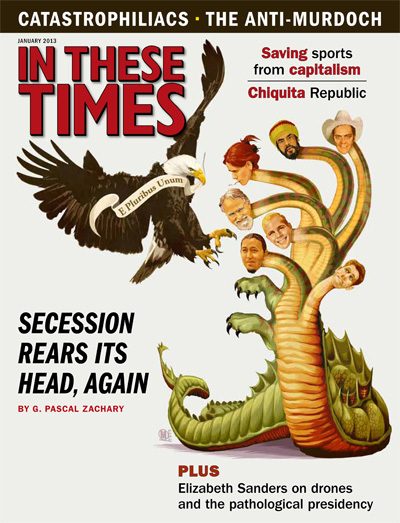On Nov. 16, 2012, an estimated 2,200 New Yorkers gathered at the Hammerstein Ballroom in Manhattan to hear 350.org’s plan to prevent catastrophic climate change. It was the 10th stop of a tour, called Do The Math, that traveled to 21 cities and featured 350.org founder Bill McKibben, author Naomi Klein and video testimonies from Kumi Naidoo, executive director of Greenpeace International, and Archbishop Desmond Tutu. The main thrust? We must stop the fossil fuel industry from extracting and burning most of earth’s below-ground reserves.
“There’s a certain amount of carbon that [fossil fuel] companies have in their reserves underground, and that figure is five times more than the allowable limit of what we can put in the atmosphere before we hit extreme runaway climate change,” says Joshua Kahn Russell, national coordinator at 350.org. Judging by several prolonged standing ovations, the audience at Hammerstein, still reeling from Hurricane Sandy, endorsed the presenters’ message. Though inured to unabashed optimism by too many years of false starts, bad compromises and slow progress, longtime activists are guardedly hopeful about the future of the movement.
This hope is in part thanks to the reverberations of Occupy Wall Street. When OWS emerged in the fall of 2011, it revitalized every sphere of American activism at the same time it was blurring the lines between different movements. “There’s a growing understanding that there’s a significant nexus between those industries that are creating — or manufacturing — climate change, your child’s asthma, poor working conditions through out the ‘developing world,’ and the financial collapse,” says Robert Gardner, who worked on Greenpeace’s anti-coal campaign. “Bank of America is foreclosing on people wholesale, but they’re also funding mountaintop removal mining.”
But while this broadening of the movement — through which environmental issues are also viewed as social justice and economic issues — has given environmentalists new reason to hope, it also presents established environmental organizations with new challenges. How to engage as many people as possible? Which strategies have a real chance to stop the fossil fuel industry, and which ones do not? And in a large and diverse movement, how do you ensure that people act strategically and efficiently?
What kinds of actions?
Potential tactics for climate activists fall along a wide spectrum. On one end are safe and legal options: petitions, electoral campaigning, legal obstruction, boycotts, strikes. Then there are peaceful tactics that fall into legal gray areas or unabashedly break the law: sit-ins, blockades, physical obstruction. At the far end is property destruction, sabotage and violence.
McKibben’s tour began the discussion on the “safe and legal” side of the spectrum, with a campaign of divestment called “Fossil Free” — getting universities, pension funds and governments to stop investing in fossil fuel companies. In his video, Archbishop Tutu explained how such a campaign helped end apartheid in South Africa.
However, no one, including 350.org, suggests that divestment alone will work. The tour’s website says that, to fight the richest industry in history, “we have our own currency: creativity, courage and if needed, our bodies.” In other words, civil disobedience or direct action. And that requires good planning.
“A great myth in American history,” says Scott Parkin, an organizer with Rainforest Action Network (RAN), “is that Rosa Parks just spontaneously sat down on a bus. But she was actually part of a campaign” that had been in the works for months. (Indeed, several other activists had already tried the protest but hadn’t received the same media attention.)
Carefully planned direct action is alive and well in east Texas, where members of the Tar Sands Blockade have carried out 14 different actions to stop construction of the southern portion of the Keystone XL pipeline. The tactics thus far have included a tree-sit-in now in its third month, work stoppages in which blockaders locked themselves to machinery, an innovative action in which people sealed themselves inside the pipe itself and an ongoing hunger strike. Cumulatively, the blockade has stopped work at various sites for several weeks. And climate activists from around the country will be converging in East Texas from January 3 to 8 for a training camp and mass action.
What will the movement look like?
For those trying to realize a sustainable future, there are two approaches: attack, reform, and otherwise engage the existing system to create structural changes, or build new systems from the ground up. The Do The Math tour falls into the first category. One of its central themes is a refutation of the idea that, because we all drive cars or heat our homes, we’re all equally responsible and that individuals just need to reduce their impact.
“Of course you should try to reduce your footprint,” says 350.org’s Kahn Russell, “but the way the math adds up is that we’re not all equally responsible. Our society is addicted to fossil fuels, and to fight that we need to go after the drug pushers. … It goes back to that Utah Phillips quote, ‘The Earth is not dying. It is being killed, and those who are killing it have names and addresses.’”
350.org may be specifically focused on oppositional direct action, but some activists think that the broader climate movement needs both approaches; it needs to destroy the fossil fuel industry while simultaneously creating an alternative. For that to be possible, a lot more people need to become active.
“The challenge is to meet people at the point of engagement that they’re ready for,” says Nathan Santry, actions director at Greenpeace. “You go to a big public rally and you see a thousand people and there are grandmothers and kids there. It’s a fairly safe place to join in. And those rallies get bigger over time, and people go ‘Well, wait a minute, I’ve been going to rallies for a while and I’ve been writing my petitions and I feel like I want to go out and take it to the next level.’ ”
In order to empower people to do that, 350.org plans to follow up the tour with a series of trainings called “The Aftermath,” specifically tailored to the needs of each community or campus. For example, says 350.org cofounder Phil Aroneanu,“if a campus is planning to occupy an administrative building, we’ll do a direct action training with them. If we find… that everything is kind of fractured and there isn’t a lot of community alignment on what they want to work on, then we may do an organizing training or strategy session.”
In terms of lifestyle, no one expects that everyone will suddenly cancel the family vacation because of carbon-miles. Instead, the strategy is to approach people on their own terms and get them to make reasonable changes.
“When you meet people where they’re at,” says Gardner, “you take away a bit of the ammunition from these corporations’ public relations firms that environmentalists just want to destroy the world, and everybody parks their cars and we’ll all sit in the dark like a bunch of druids.”
On the capacity-building side, the real challenge is to create alternative, sustainable networks and infrastructures that appeal to a broad base of people. This seems to be happening. Urban farmers are reclaiming vacant lots as community gardens, reducing crime rates and improving local nutrition. A proposed project in Detroit, the capital of vacant lots, would create the world’s largest urban farm. Urbanites around the country are campaigning for the right to raise chickens in their backyards. School garden programs are teaching children where their food comes from. Municipalities are realizing that they can build their own solar installations and wind turbines and actually save money. Bicycle co-ops and tool-lending libraries are not only making transportation and home repair affordable for more people, but they’re fostering community and the free exchange of technical knowledge.
Whatever people do, Kahn Russell says, it’s more powerful as a group. “Working on an organic farm is great, but working in conjunction with a federation of organic farms to organize and make sure you’re tapped into local food justice movements so that there are farmers’ markets with cheap organic food in the city, that’s even better.”
This ethic of mutual assistance “is what will carry us through the next century in an era of potential resource scarcity,” says Kahn Russell. “What the right wing is offering in the face of resource scarcity is a recipe that requires sacrifice, but the sacrifice that it requires is on the backs of vulnerable people, on the backs of poor people and the backs of communities of color.
“When you look at U.S. history, during World War II, the ethic was collective action and shared sacrifice,” Kahn Russell continues. “There was a value put on thrift and community. … I don’t view, on a personal level, what we need to do as deprivation or sacrifice. It’s actually an affirming part of the human experience that many people in our country yearn for.”







